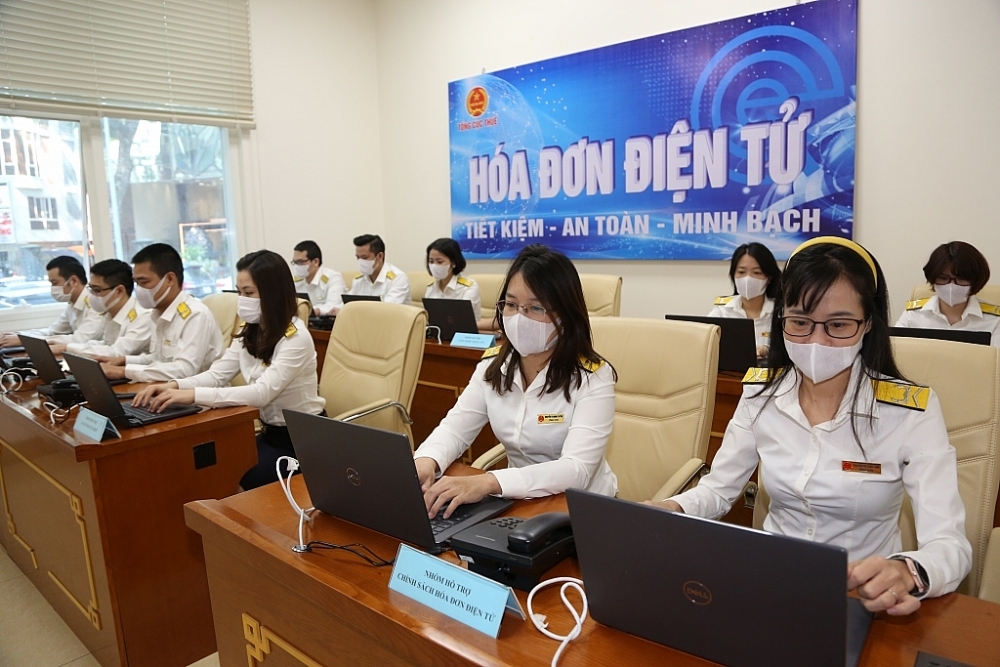Tổng số bài đăng 462.
 The Tax sector is ready to execute the second phase of e-invoices, aiming for all taxpayers to use e-invoices by July 1.
The Tax sector is ready to execute the second phase of e-invoices, aiming for all taxpayers to use e-invoices by July 1.
Six provinces and cities agree to use e-invoices
With the goal that all taxpayers will use e-invoices by July, the Ministry of Finance approved the use of e-invoices under the two-phase roadmap. The first phase was implemented six provinces and cities (including Hanoi, HCM City, Hai Phong, Quang Ninh, Binh Dinh and Phu Tho) since November 21. The second phase is executed in 57 provinces and cities from April 2022.
According to the General Department of Taxation, as of March 31, the Tax sector received and processed applications for using e-invoices of 423,103 organizations, reaching 92.5% of the target and 20,688 business households, meeting 100% of the target. As of March 31, the tax authorities handled 58.2 million invoices.
During implementation, the sector has faced difficulties. Some enterprises and organizations have not yet agreed to use e-invoices in accordance with Circular 78/2021/TT-BTC.
For example, solutions of some e-invoice service providers have not met requirements on the stamp, warehouse export; the business has subsidiaries located outside provinces and cities that implement e-invoices in the first phase but they use an accounting system in their headquarters. Household businesses are mainly small businesses that have limitations in IT , so they suffer difficulties in using e-invoices.
Ready for executing the second phase of using e-invoices
On February 24, the Ministry of Finance issued Decision 206/QD-BTC applying e-invoice in 57 provinces and centrally-run cities, and Dispatch 1799/BTC-TCT requesting localities to coordinate the use of e-invoices.
Currently, 57 tax departments are ready for the implementation of the second phase.
To meet requirements in the second phase, the country’s top tax regulator has upgraded the e-invoice application to satisfy requirements of authorization when the system of the tax authorities has errors, and to meet the regulations on authorizing the making of e-invoices, adding reports summarizing implementation progress, reports on collecting data and completing utilities to facilitate taxpayers and tax officials in using the software.
In addition, the General Department of Taxation has also reviewed and added the technical infrastructure capacity to serve the performance of the second phase in 57 provinces and cities from April, and continued to carry out procedures for equipping and upgrading technical infrastructure to meet the requirements of receiving e-invoice data when corporations and 63 provinces and cities apply e-invoices.
The top tax regulator has organized training on policies, operational processes, regulations on data components and some basic functions of e-invoice management software for 57 tax departments.
On March 25, the tax authorities held a conference to discuss with organizations providing e-invoice services and 57 local tax departments to agree on plans, roadmaps, coordination methods as well as responsibilities of tax agencies and service providers.
The Tax sector sets the goal of achieving 70% of the target at the end of May 31 and strives to reach 100% of businesses, economic organizations, business households and business economic organizations, business households and business individuals applying e-invoices.
Then, 100% of enterprises, economic organizations, business households and business individuals must use e-invoices by the end of June 30, 2022.
Source: Customs News









